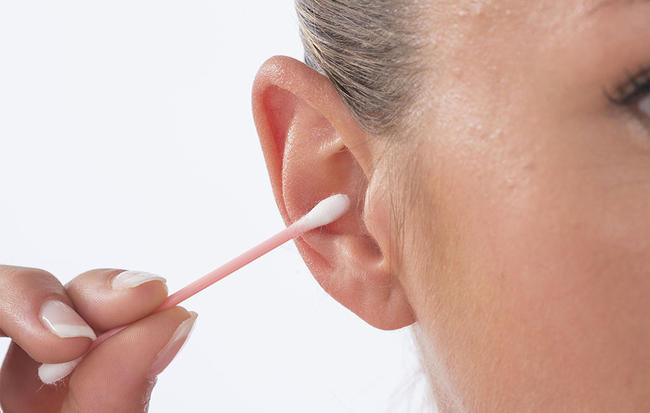“Don’t put anything smaller than your elbow in your ear.” That’s an official recommendation from the 2017 American Academy of Otolaryngology (AAOHNS) ear health guidelines. And yet, we continue to use Q-Tips and cotton swabs.
According to the AAOHNS, millions of Americans put all types of “tools” in their ear canals in an effort to scratch an itch, remove wax, or dry off after a shower. Surprisingly, the list includes all sorts of items, including, paper clips and pen caps. But by far the most common culprit is the Q-Tip. The super-soft swab seems like a perfect match for the ear, despite a warning clearly printed on each box that says: “Do not insert swab into ear canal. Entering the ear canal could cause injury. If used to clean ears, stroke swab gently around the outer surface of the ear only.” But is the Q-Tip company just being cautious? Or do we actually need to quit swabbing our ears?
According to M. Jennifer Derebery, MD, who specializes in ear disorders at the House Clinic in Los Angeles, using Q-tips inside the ear is a hard no. “I have seen a number of ear infections and perforated eardrums and even dislocated ear bones (ossicles) from too vigorous cleaning,” she says. “If one is compelled to use Q-tips, then clean the outer ‘bowl’ of the ear and leave the canal alone.” But using Q-Tips on the outer ear can be a slippery slope. Like answering a text during a movie, moving to the inner ear can be hard to resist—despite the fact that we know we shouldn’t do it.
Many Q-Tip fans say they first get addicted to the sensation of the swab gently massaging the ear. All it takes is one little itch, says Abbas Anwar, MD, an otolaryngologist practicing in Santa Monica, California. “There are actually four different cranial nerves that innervate the ear canal,” he notes. “Because all those nerve endings are packed within such a small space, it is a very sensitive area. That means the softness of a Q-Tip can feel very pleasurable for some people.”
And of course, there’s the issue of cleanliness. Although wax removal is a common reason people turn to the swabs, it’s usually not necessary, experts say. Left to its own devices, earwax, or cerumen, can take care of itself. Cerumen naturally migrates down and out of the ear canal into the outer ear, propelled along in a conveyer belt style by our jaw motions. Once there, it can be more safely removed with a tissue-covered finger
What’s more, letting earwax do its thing has real benefits. “Wax is good,” Derebery says. “It kills bacteria. It moistens the skin. It’s sticky, so if a foreign body, say, an insect, enters the ear, it will trap it and prevent it from going down to the eardrum and rupturing it.” Wait, what? Bugs? Yes, confirms Anwar. While the bug issue is rare, wax can help trap smaller insects before they get deeper into the ear canal.
In addition to injury, the overzealous swabber who pushes Q-Tips deep inside the ear to remove wax can actually make matters worse, Anwar says. “Q-tips can end up pushing ear wax further into your ear. As this piles up against your eardrum, your hearing can be severely affected.” Once this happens, cerumen can become hard and impacted, and may need to be removed by a doctor. “We have special instruments and suction devices and can visualize your ear under a microscope to precisely and thoroughly clean out your ear canal,” Anwar explains.
Thankfully for ear swabbers, Anwar says there are plenty of safe alternatives that can help you keep your ears feeling clean. Here are two safe techniques worth trying:

Hydrogen peroxide: Got too much wax? A 2012 study showed that once-weekly irrigations of the ear canal with 70% isopropyl alcohol could significantly reduce the amount of wax clogging the ear canal. A few drops of hydrogen peroxide can soften earwax, so it comes out more easily, Anwar says.“You can also buy an over the counter product such as Debrox ($6, amazon.com), which are drops that can also help to soften the wax.” Once softened, the wax will migrate to the outer ear, where it can be safely washed or wiped away.
Note: Another wax removal method, called candling, which involves placing a hollow candle in the ear canal, is strongly discouraged by the academy. “We do not recommend any other over the counter product such as ear candling, as this can be dangerous,” Anwar says. (You should also avoid these other absolute worst ways to clear your ears.)
Tissue: If you really can’t resist getting in there, Anwar says wrapping a tissue around your fingertip to gently clean the outer ear, and the outer rim of the ear canal opening is better than using a swab. “That’s perfectly okay, as long as you aren’t using your pinky to get the tissue deeper into the canal.” Gently wiping the outer ear with a washcloth can also help.












